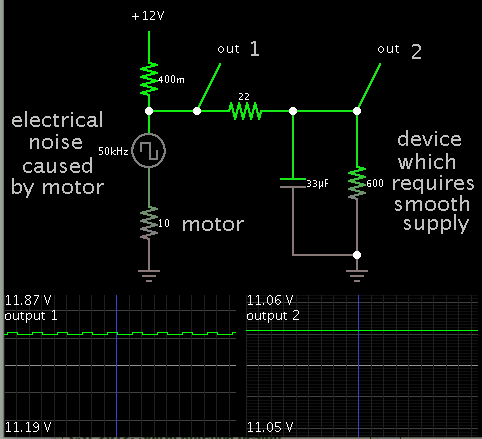giovaniluigi
Member level 1

- Joined
- May 30, 2009
- Messages
- 32
- Helped
- 0
- Reputation
- 0
- Reaction score
- 0
- Trophy points
- 1,286
- Activity points
- 1,626
I have a circuit that needs a 12V power line and for that I built a DC-DC converter with 12V output (5A).
This 12V line is used to power a small DC brushed motor (1A working) and a pressure sensor.
The sensor circuitry is an industrial standard that draws 4-20mA proportional to its input.
In order to power the sensor with this line, I want to remove any noise and transients that the DC brushed motor may produce.
I'm considering to use a simple inductor to remove the noise.
Ideally the frequency allowed to pass should be very low... But I have some constraints for components size...
So first I'll start filtering anything above 200Khz with the inductor and then I can use a capacitor to filter noises from 10Khz - 200Khz
I'm just a bit confuse how should I calculate the value of my inductor.
For a LR filter the formula is fc = R / 2π * L
I replaced the R with the sensor's impedance assuming sensor current = 20mA, and then I got 470µH for fc = 203 Khz
Is this correct ?
Can anybody suggest a better approach ? May be using inductor + capacitor...
This 12V line is used to power a small DC brushed motor (1A working) and a pressure sensor.
The sensor circuitry is an industrial standard that draws 4-20mA proportional to its input.
In order to power the sensor with this line, I want to remove any noise and transients that the DC brushed motor may produce.
I'm considering to use a simple inductor to remove the noise.
Ideally the frequency allowed to pass should be very low... But I have some constraints for components size...
So first I'll start filtering anything above 200Khz with the inductor and then I can use a capacitor to filter noises from 10Khz - 200Khz
I'm just a bit confuse how should I calculate the value of my inductor.
For a LR filter the formula is fc = R / 2π * L
I replaced the R with the sensor's impedance assuming sensor current = 20mA, and then I got 470µH for fc = 203 Khz
Is this correct ?
Can anybody suggest a better approach ? May be using inductor + capacitor...



